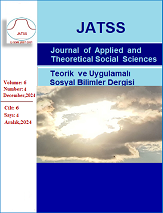Nijerya'da İklim Değişikliğinin Sağlık Harcamaları Üzerindeki Asimetrik Etkileri: Doğrusal Olmayan ARDL Modelinden EldeEdilen Kanıtlar
Özet
Giriş: Bu çalışma, iklim değişikliğinin Nijerya'nın sağlık harcamaları üzerindeki asimetrik etkilerini göstermektedir. İklim değişikliği, dünyanın karşı karşıya olduğu en büyük çevresel zorluklardan biri olarak kabul edilmekte ve insan sağlığı için ciddi bir tehdit oluşturmaktadır. Günümüzde dünya genelinde iklime duyarlı hastalıkların artan yaygınlığı büyük ölçüde çevresel bozulmanın bir sonucudur. İklim şokları ve ilişkili aşırı hava koşulları, insan sağlığı üzerinde büyük zorluklar yaratmış ve hükümet ve hanehalkı sağlık harcamalarında artışa yol açmıştır.
Yöntem: 1990'dan 2023'e kadar olan dönemde Granger nedensellik testiyle birlikte doğrusal olmayan otoregresif dağıtılmış gecikme (NARDL) yaklaşımı kullanılarak bir zaman serisi analizi yürütülmüştür. İklim değişikliği, karbon emisyonu (CO2) ve sıcaklık anomalileri kullanarak ölçülmüştür. Değişkenlerin olası asimetrik etkilerini belirlemek için karbon emisyonu (CO2) ve sıcaklık anomalisi pozitif ve negatif kısmi toplamlara ayrılmıştır.
Sonuçlar ya da Bulgular: Bulgular, pozitif sıcaklık ve CO2 şoklarının hem kısa hem de uzun vadede maliyetleri önemli ölçüde artırdığını ve iklim için eyleme geçmenin aciliyetini vurgulamaktadır. Tersine, negatif CO2 şokları uzun vadeli sağlık harcamalarında azalmaya yol açar, bu da CO2’i azaltmanın potansiyel etkisini göstermektedir. CO2 emisyonlarından kişi başına düşen sağlık harcamalarına doğru kurulan tek yönlü nedensellik, emisyon azaltma hedefli politikaların uygulanmasının gerekliliğini güçlendirmiştir.
Tartışma ya da Yapılan Çıkarımlar: Sıcaklık ve CO2'deki pozitif şokun sağlık harcamalarını önemli ölçüde artırdığı bulgusu, iklim değişikliğiyle mücadele stratejilerine acil ihtiyaç olduğunu ortaya koymuştur.
##plugins.generic.paperbuzz.metrics##
Referanslar
Aboubacar, B., & Xu, D. (2017). The impact of health expenditure on the economic growth in sub-Saharan Africa. Theoretical Economics Letters, 7(3), 615-622.
https://doi.org/10.4236/tel.2017.73046
Adenle, A.A., Hossein, A., & Joseph, A. (2015). Global assessment of technological innovation for climate change adaptation and mitigation in developing world, Journal of Environmental Management,161, 261-275.
https://doi.org/10.1016/j.jenvman.2015.05.040
Akpan, U.F., & Chuku, A. (2011, April 27). Economic growth and environmental degredation in Nigeria. Beyond the environmental kuznet curve. MPRA Paper No.31241, https://mpra.ub.uni-muenchen.de/31241/
Ali, M., Awe, E. O., Mohammed, S. S., & Isah, K. O. (2024). Industrialization, FDI inflow and climate change in Africa: A scenario analysis, Chinese Journal of Urban and Environmental Studies, 12(1), 2450003-1 to 2450003-20. https://doi.org/10.1142/S2345748124500039
Anwar, A., Hyder, S., Bennett, R., &Younis, M. (2022). Impact of environmental quality on healthcare expenditures in developing countries. A panel data approach. Healthcare 10(9),1608-1 to 1608-11. https://doi.org/10.3390/healthcare10091608
Apergis, N., Jebli, M.B., &Youssef, S.B. (2018). Does renewable energy consumption and health expenditures decrease carbon dioxide emissions? Evidence from sub-Saharan African countries. Renewable Energy, 127, 1011-1016.
https://doi.org/10.1016/j.renene.2018.05.043
Apergis, N. (2016). Environmental kuznet curves: New evidence on both panel and country-specific C02 emissions. Energy Economics, 54 (3), 263-271. https://doi.org/10.1016/j.eneco.2015.12.007
Azam, M. & Awan, A.M. (2022). Health is wealth: A dynamic SUR approach of examining a link between climate changes and human health expenditures. Social Indicators Research, 163(2), 505–528 https://doi.org/10.1007/s11205-022-02904-x
Barati, M., & Fariditavana, H. (2020). Asymmetric effect of income on the US health expenditure: Evidence from the nonlinear autoregressive distributed lag (ARDL) approach. Empirical Economics, 58, 1979-2008. https://doi.org/10.1007/s00181-018-1604-7
Bhatti, M. A., Ur-Raheem, F., & Zafar, M. A. (2020). Environmental kuznets curve: Empirically examined long run association between globalization, financial development and co2 emission for ASEAN countries. iRASD Journal of Energy & Environment, 1(1), 1-13. https://doi.org/10.52131/jee.2020.0101.0001
Boachie, M. K., Mensah, I. O., Sobiesuo, P., Immurana, M., Iddrisu, A.A., & Kyei-Brobbey, I. (2014). Determinants of public health expenditure in Ghana: A cointegration analysis. Journal of Behavioural Economics, Finance, Entrepreneurship, Accounting and Transport, 2(2), 35-40. https://doi.org/10.12691/jbe-2-2-1
Chaabouni, S., & Saidi, K. (2017). The dynamic links between carbon dioxide (〖CO〗_2) emissions, health spending and GDP growth: A case study for 51 countries. Environmental Research, 158, 137-144. https://doi.org/10.1016/j.envres.2017.05.041
Chen, L., Zhuo, Y., Xu, Z., Xu, X., & Gao, X (2019). Is carbon dioxide (〖CO〗_2) emission an important factor affecting health care expenditure? evidence from China, 2005-2016. International Journal of Environmental Research and Public Health, 16(20),3995. https://doi.org/10.3390/ijerph16203995
Cheng, C., Ren, X., Zang, M., & Wang, Z. (2024). The nexus among C02 emission, health expenditure and economic development in the OECD countries: New insights from a cross-sectional ARDL model: Environmental Science Pollution Research,31,16746-16769 https://doi.org/10.1007/s11356-024-32081-y
Chien, F., Chau, K. Y., & Sadiq, M. (2023). Impact of climate mitigation technology and natural resource management on climate change in China. Resources Policy, 81, 103367. https://doi.org/10.1016/j.resourpol.2023.103367
Eckelman, M. J., Huang, K., Lagasse, R., Senay, E., Dubrow, R., & Sherman, J. D. (2020). Health care pollution and public health damage in the United States: An update: Health Affairs, 39(12), 2071–2079. https://doi.org/10.1377/hlthaff.2020.01247
Erdogan, S., Kirca, M., & Gedikli, A. (2020). Is there a relationship between 〖CO〗_2emissions and health expenditures? Evidence from BRICS-T countries. Business and Economics Research Journal, 11(2), 293–305. https://doi.org/10.20409/berj.2019.231
Erdoğan, S., Yıldırım, D. Ç., & Gedikli, A. (2019). The relationship between 〖CO〗_2 emissions and health indicators: The case of Turkey. Economic Letters, 6(1), 28-39.
FAO, IFAD, UNICEF, WFP and WHO. (2023). The state of food security and nutrition in the world 2023. Urbanization, agrifood systems transformation and healthy diets across the rural–urban continuum. FAO. https://doi.org/10.4060/cc3017en
Frankovic, I. (2017). The impact of climate change on health expenditures. Econ WPS No. 02/2017, Vienna University of Technology Institute of Statistics and Mathematical methods in Economics, Research Group Economics. Retrieved July 12, 2024, from https://hdl.handle.net/10419/149991
Govindaraju, V. C., & Tang, C. F. (2013). The dynamic links between 〖CO〗_2 emissions, economic growth and coal consumption in China and India. Applied Energy, 104, 310-318. https://doi.org/10.1016/j.apenergy.2012.10.042
Pörtner, H.O., Roberts, D.C., Tignor, M., Poloczanska, E.S., Mintenbeck, K., Alegría, A., Craig, M., Langsdorf, S., Löschke, S., Möller, V., Okem, A.& Rama B. (eds.). (2022). Climate change 2022: Impacts, adaptation and vulnerability. Contribution of working group II to the sixth assessment report of the ıntergovernmental panel on climate change, Cambridge University Press. https://doi.org/10.1017/9781009325844 .
Lee, H & Romero J. (eds.). (2023). Summary for policymakers. In: Climate change 2023: synthesis report. contribution of working groups I, II and III to the sixth assessment report of the intergovernmental panel on climate change, IPCC, https://doi.org/10.59327/IPCC/AR6-9789291691647.001
Field, C.B., Barros, V.R., Dokken, D.J., Mach, K.J., Mastrandrea, M.D., Bilir, T.E., Chatterjee, M., Ebi, K.L., Estrada, Y.O., Genova, R.C., Girma, B., Kissel, E.S., Levy, A.N., MacCracken, S., Mastrandrea, P.R., & White L.L. (eds.) (2014). Impacts, adaptation, and vulnerability. Part A: Global and sectoral aspects. Contribution of working group II to the fifth assessment report of the ıntergovernmental panel on climate change. Cambridge University Press.
Khoshnevis, Y.S., & Khanalizadeh, B. (2017). Air pollution, economic growth and health care expenditure. Economic Research-Ekonomskaistraživanja, 30(1), 1181-1190. https://doi.org/10.1080/1331677X.2017.1314823
Kutlu, G., & Örün, E. (2022). The effect of carbon dioxide emission, GDP per capita and urban population on health expenditure in OECD countries: A panel ARDL approach. International Journal of Environmental Health Research. 1–10. https://doi.org/10.1080/09603123.2022.2083088
Lu, Z.N, Chen, H., Hao, Y., Wang, J, Song, X., & Mok, T.M. (2017) The dynamic relationship between environmental pollution, economic development and public health: Evidence from China. Journal of Clean Production, 166, 134-147.
https://doi.org/10.1016/j.jclepro.2017.08.010
Mehfoz, S., Mansha, M., Khan, M., & Musharaf, S. (2023). 〖CO〗_2emissions, health expenditures, and economic growth nexus in Pakistan. IRASD Journal of Energy & Environment, 4(1), 16–29. https://doi.org/10.52131/jee.2023.0401.0032
Melina, D., &Chaido, D. (2023). The relationship between health expenditure, 〖CO〗_2 emissions, and economic growth in G7: Evidence from heterogeneous panel data. Journal of Knowledge Economies,4:1-26. https://doi.org/10.1007/s13132-023-01349-y
Pesaran, M., Shin, Y. & Smith, J. (2001). Bounds testing approaches to the analysis of level relationships. Journal of Applied Econometrics, 16(3), 289–326.
Samah, I. H. A., Abd Rashid, I. M., Husain, W. A. F. W., Ibrahim, S., Hamzah, H., & Amlus, M. H. (2020). The impact of healthcare expenditure and healthcare sector growth on 〖CO〗_2 emission using dynamic panel data system GMM estimation model during COVID 19 crisis, International Journal of Energy Economics and Policy,10(6), 235–241. https://doi.org/10.32479/ijeep.9769
Shin, Y., Yu, B., & Greenwood-Nimmo, M.G. (2014). Modeling asymmetric co integration and dynamic multipliers in a nonlinear ARDL framework. In R.C. Sickles & W.C. Horrace (Eds.) Festschrift in honor of Peter Schmidt Econometric Methods and Applications Springer.
Siami-Namini, S. (2018). Healthcare expenditure, economic growth, and inflation in the G7 countries: A panel co-integration approach. Research Journal of Economics, 2(2), 1–8.
Sileem, H. H. M. (2016). Health expenditure, climate changes and corruption in the MENA region: A granger causality approach. Journal of African Development, 18(2), 61–72.
Socol, A., Iuga, H., Socol, D., & Iuga, I. C. (2023). Does climate change drive up government healthcare costs in the European Union? Frontiers in Environmental Science,11,1-18. https://doi.org/10.3389/fenvs.2023.1286099
Song, Ma-Lin, Wei Z., & Shu-Hong, W. (2013). Infection point of environmental kuznet curve in Mainland China. Energy Policy, 57, 14–20.
Sohail, A., Du, J., & Abbasi, B. N. (2023). Exploring the interrelationship among health status, 〖CO〗_2 emissions, and energy use in the top 20 highest emitting economies: Based on the CS-DL and CS-ARDL approaches, Air Quality, Atmosphere & amp; Health, 16, 1419–1442. https://doi.org/10.1007/s11869-023-01350-z
To, W.M., & Lam, K. H. (2022). Economic growth, energy use, and greenhouse gases emission in Macao SAR, China. Chinese Journal of Urban and Environmental Studies,10(1), 2250002-1 to 2250002-21
Wang, F., Gillani, S., Nazir, R., & Razzaq, A. (2023). Environmental regulations, fiscal decentralization, and health outcomes. Energy & Environment, 35(6), 3038-3064. https://doi.org/10.1177/0958305X231164680
Wang, Z., Asghar, M. M., Zaidi, S. A. H., & Wang, B. (2019). Dynamic linkages among 〖CO〗_2emissions, health expenditures, and economic growth: Empirical evidence from Pakistan. Environmental Science and Pollution Research, 26(15), 15285-15299. https://doi.org/10.1007/s11356-019-04876-x
World Bank Group (n.d.). Climate Change Knowledge Portal. Retrieved December 17, 2024, from https://climateknowledgeportal.worldbank.org
Xu, X., Xu, Z., Chen, L., & Chang, L. (2019). How does industrial waste gas emission affect healthcare expenditure in different regions of China: An application of Bayesian quartile regression. International Journal of Environmental Research and Public Health, 16 (15),2748. https://doi.org/10.3390/ijerph16152748
Zaidi, S., & Saidi, K. (2018). Environmental pollution, health expenditure and economic growth in the sub-Saharan Africa countries: panel ARDL approach. Sustainable Cities and Society, 41, 833-840. https://doi.org/10.1016/j.scs.2018.04.034.
Zeeshan, M., Han, J., Rehman, A., Ullah, I., & Afridi, F. E. A. (2021). Exploring asymmetric nexus between 〖CO〗_2 emissions, environmental pollution, and household health expenditure in China. Risk Management and Healthcare Policy,14, 527–539. https://doi.org/10.2147/RMHP.S281729
Zhang, B., Wang, B., & Wang, Z. (2017). Role of renewable energy and non-renewable energy consumption on EKC: Evidence from Pakistan. Journal of cleaner production, 156, 855-864. https://doi.org/10.1016/j.jclepro.2017.03.203
Zhao, X., Jianmin, L., Wang, J., & Zhou, C. (2005). An empirical test of environmental kuznets’ curve in China. Nankai Economic Studies, 2005(3), 48–54


















